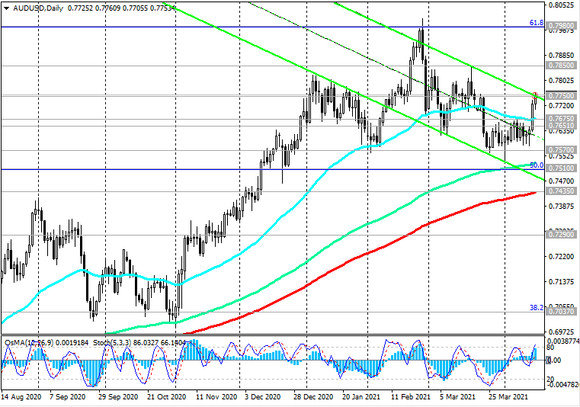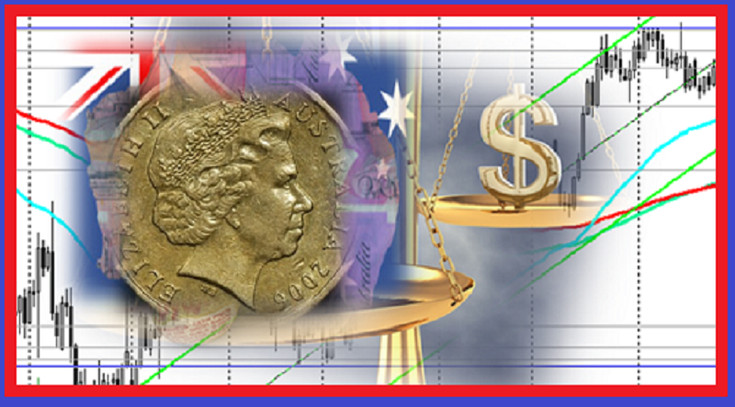The American stock index of the broad market S&P 500 updated on Wednesday a record high at around 4152.0. It was also supported by the industrial DJIA, which also renewed its all-time high on Wednesday.
One of the reasons for the continued growth is the positive quarterly reports of the largest American banks, and today a new block of reports is expected, as well as fresh economic data from the United States. At 12:30 and 13:15 (GMT), weekly data from the US labor market will be released, as well as data on the level of retail sales and industrial production in the US economy, which are expected to indicate growth in March (after falling in February). If the markets react to the positive data on the already established tradition with the growth of stock indices, then we should expect the dollar to weaken.
Another reason for the growth of stock indices and, accordingly, the weakening of the dollar was yesterday's speech by the head of the Fed, Jerome Powell. Although he did not say anything new compared to his previous statements, Powell reassured market participants that the Fed remains committed to a soft stimulus policy.
Powell spoke on Wednesday after the release of inflation indicators on Tuesday that pointed to rising consumer inflation in the United States. According to data published on Tuesday, consumer inflation in the US rose to 0.6% in March (against the forecast of 0.5% and 0.4% in February). Annual inflation in the US in March amounted to 2.6% against 1.7% in February, which exceeded the forecast of 2.5%. Inflation figures hit new highs since 2012, indicating faster consumer price increases and heightening talk about the timing of the Fed's monetary policy adjustment.
However, Powell again tried to reassure investors, saying on Wednesday that the central bank would begin to cut back on monthly asset purchases well before considering raising interest rates.
During the meeting, held March 16-17, Fed officials said they still expect interest rates to remain near zero until the end of 2023, and did not express their readiness to wind down the bond purchase program.
Earlier Powell promised that the Fed would give early warning of the possible timing of the start of the rollback of bond purchases, which now amount to $ 120 billion a month.
At a press conference after the March meeting, Fed Chairman Powell said current "monetary policy will continue to provide strong support to the economy until its recovery is complete".
Today, futures for US stock indices are growing again, receiving support from the continuing propensity of investors to buy risky high-yielding assets (primarily shares of large American companies).
At the same time, against the background of rising stock indices, commodity prices and a weakening dollar, commodity currencies continue to strengthen. Thus, the AUD / USD pair renewed its 4-week high above 0.7759 at the beginning of the European session today, testing the strong resistance level of 0.7750 for a breakout (see Technical Analysis and Trading Recommendations).

The Australian currency also received support today from the publication of data from the Australian labor market at the beginning of the Asian session. According to the Australian Bureau of Statistics, the number of jobs in March rose by 70,700, while unemployment fell to 5.6% from 5.8% in February (the forecast was +35,000 and 5.7%, respectively).
In March, for the first time since the onset of the Covid-19 pandemic, there was also an increase in hours worked.
As shown by macro statistics, employment in Australia has been recovering very quickly in recent months, as is overall economic activity, which has grown at its highest rate in 70 years. Hiring is boosted by an improved business environment, which has driven consumer confidence to its highest level in a decade. So, published on Tuesday, the consumer confidence index (calculated by Westpac and the Melbourne Institute) in April rose by 6.2% to 118.8 points against 111.8 in March. This is the highest since August 2010, when Australia's economy was recovering from the global financial crisis.
Tomorrow, another increase in volatility is expected in the AUD / USD pair, when a block of important macro statistics on China will be published at 02:00 (GMT). China is the largest buyer of raw materials and a supplier of a wide range of finished products to the world commodity market. China's economy is already the first in the world, according to some reports, pushing the American economy to second place. Therefore, the publication of important macroeconomic indicators from China can have a strong impact on the entire financial market. China is also Australia's largest trade and economic partner and buyer of its commodities, and positive macro statistics from China may also have a positive effect on AUD quotes.
China's GDP is expected to grow by +1.5% in the first quarter of 2021 (+18.9% on an annualized basis). This is a record rate of growth in China's annual GDP. According to economists, the growth of the Chinese economy in 2021 as a whole may be 8.6% against 2.3% in 2020. This will be the strongest indicator in the last 10 years.
Economists also expect that in March compared to March last year, the growth of retail sales in China slowed to 28% from 33.8% in January-February, the growth of investment in fixed assets in the 1st quarter - to 26.4% from 35.0% in January-February, and industrial production - up to 16.5% from 35.1%. Despite the relative decline, these are strong indicators.





